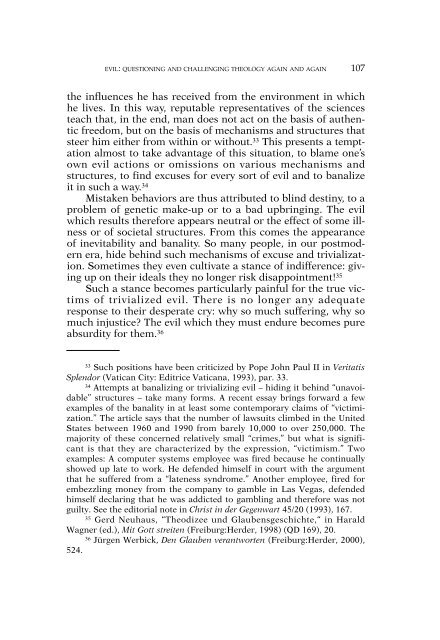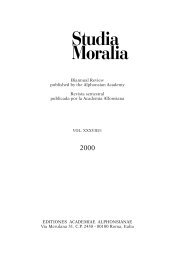- Page 1 and 2:
StudiaMoraliaBiannual Reviewpublish
- Page 3 and 4:
4Reviews / RecensionesBONANDI, ALBE
- Page 5 and 6:
6 SUMMARIES / RESUMENESteologia mor
- Page 7 and 8:
8 SUMMARIES / RESUMENES‘Globaliza
- Page 9 and 10:
10 SUMMARIES / RESUMENESche del sis
- Page 11 and 12:
Alla luce della riscoperta concilia
- Page 13 and 14:
StMor 44 (2006) 15-40JOSEPH A. SELL
- Page 15 and 16:
THE SUBJECT-OBJECT RELATION IN CONT
- Page 17 and 18:
THE SUBJECT-OBJECT RELATION IN CONT
- Page 19 and 20:
THE SUBJECT-OBJECT RELATION IN CONT
- Page 21 and 22:
THE SUBJECT-OBJECT RELATION IN CONT
- Page 23:
THE SUBJECT-OBJECT RELATION IN CONT
- Page 26 and 27:
28 JOSEPH A. SELLINGWith respect to
- Page 28 and 29:
30 JOSEPH A. SELLINGbetween proport
- Page 30 and 31:
32 JOSEPH A. SELLINGposes of both p
- Page 32 and 33:
34 JOSEPH A. SELLINGWhat most peopl
- Page 34 and 35:
36 JOSEPH A. SELLINGgive a gift tha
- Page 36 and 37:
38 JOSEPH A. SELLINGent aspects of
- Page 38 and 39:
40 JOSEPH A. SELLINGanother aspect
- Page 40 and 41:
42 BRIAN V. JOHNSTONEmake it possib
- Page 42 and 43:
44 BRIAN V. JOHNSTONEunified theolo
- Page 44 and 45:
46 BRIAN V. JOHNSTONEvirtue calls f
- Page 46 and 47:
48 BRIAN V. JOHNSTONEthat we cannot
- Page 48 and 49:
50 BRIAN V. JOHNSTONEby which he me
- Page 50 and 51:
52 BRIAN V. JOHNSTONEgestion that w
- Page 52 and 53:
54 BRIAN V. JOHNSTONEare intelligib
- Page 54 and 55: 56 BRIAN V. JOHNSTONEdeath, in rela
- Page 56 and 57: 58 BRIAN V. JOHNSTONEterms of an ob
- Page 58 and 59: 60 BRIAN V. JOHNSTONEacter of the n
- Page 60 and 61: StMor 44 (2006) 63-92GIOVANNI DEL M
- Page 62 and 63: IMPLICANZE CANONISTICHE DELL’AIDS
- Page 64 and 65: IMPLICANZE CANONISTICHE DELL’AIDS
- Page 66 and 67: IMPLICANZE CANONISTICHE DELL’AIDS
- Page 68 and 69: IMPLICANZE CANONISTICHE DELL’AIDS
- Page 70 and 71: IMPLICANZE CANONISTICHE DELL’AIDS
- Page 72 and 73: IMPLICANZE CANONISTICHE DELL’AIDS
- Page 74 and 75: IMPLICANZE CANONISTICHE DELL’AIDS
- Page 76 and 77: IMPLICANZE CANONISTICHE DELL’AIDS
- Page 78 and 79: IMPLICANZE CANONISTICHE DELL’AIDS
- Page 80 and 81: IMPLICANZE CANONISTICHE DELL’AIDS
- Page 82 and 83: IMPLICANZE CANONISTICHE DELL’AIDS
- Page 84 and 85: IMPLICANZE CANONISTICHE DELL’AIDS
- Page 86 and 87: IMPLICANZE CANONISTICHE DELL’AIDS
- Page 88 and 89: IMPLICANZE CANONISTICHE DELL’AIDS
- Page 90 and 91: StMor 44 (2006) 93-120BRUNO HIDBER
- Page 92 and 93: EVIL: QUESTIONING AND CHALLENGING T
- Page 94 and 95: Finally even what humanity defines
- Page 96 and 97: EVIL: QUESTIONING AND CHALLENGING T
- Page 98 and 99: EVIL: QUESTIONING AND CHALLENGING T
- Page 100 and 101: EVIL: QUESTIONING AND CHALLENGING T
- Page 102 and 103: EVIL: QUESTIONING AND CHALLENGING T
- Page 106 and 107: EVIL: QUESTIONING AND CHALLENGING T
- Page 108 and 109: EVIL: QUESTIONING AND CHALLENGING T
- Page 110 and 111: EVIL: QUESTIONING AND CHALLENGING T
- Page 112 and 113: EVIL: QUESTIONING AND CHALLENGING T
- Page 114 and 115: EVIL: QUESTIONING AND CHALLENGING T
- Page 116 and 117: EVIL: QUESTIONING AND CHALLENGING T
- Page 118 and 119: StMor 44 (2006) 121-139FAUSTINO PAR
- Page 120 and 121: OLTRE M. NOVAK PER UNA PRATICA CRIS
- Page 122 and 123: OLTRE M. NOVAK PER UNA PRATICA CRIS
- Page 124 and 125: OLTRE M. NOVAK PER UNA PRATICA CRIS
- Page 126 and 127: OLTRE M. NOVAK PER UNA PRATICA CRIS
- Page 128 and 129: OLTRE M. NOVAK PER UNA PRATICA CRIS
- Page 130 and 131: OLTRE M. NOVAK PER UNA PRATICA CRIS
- Page 132 and 133: OLTRE M. NOVAK PER UNA PRATICA CRIS
- Page 134 and 135: OLTRE M. NOVAK PER UNA PRATICA CRIS
- Page 136 and 137: OLTRE M. NOVAK PER UNA PRATICA CRIS
- Page 138 and 139: 142 SILVIO BOTEROxión acerca del
- Page 140 and 141: 144 SILVIO BOTEROy teólogos, afirm
- Page 142 and 143: 146 SILVIO BOTEROteológica de los
- Page 144 and 145: 148 SILVIO BOTEROLa crisis de renov
- Page 146 and 147: 150 SILVIO BOTERO2. EL TEÓLOGO MOR
- Page 148 and 149: 152 SILVIO BOTEROAparece también i
- Page 150 and 151: 154 SILVIO BOTEROlas circunstancias
- Page 152 and 153: 156 SILVIO BOTEROmoralista postconc
- Page 154 and 155:
158 SILVIO BOTEROse lanzó al traba
- Page 156 and 157:
160 SILVIO BOTEROdividida entre la
- Page 158 and 159:
162 SILVIO BOTEROles en la iglesia
- Page 160 and 161:
StMor 44 (2006) 165-180EUGENIO CAPE
- Page 162 and 163:
LO SPIRITO SANTO E LA COSCIENZA MOR
- Page 164 and 165:
LO SPIRITO SANTO E LA COSCIENZA MOR
- Page 166 and 167:
LO SPIRITO SANTO E LA COSCIENZA MOR
- Page 168 and 169:
LO SPIRITO SANTO E LA COSCIENZA MOR
- Page 170 and 171:
LO SPIRITO SANTO E LA COSCIENZA MOR
- Page 172 and 173:
LO SPIRITO SANTO E LA COSCIENZA MOR
- Page 174 and 175:
LO SPIRITO SANTO E LA COSCIENZA MOR
- Page 176 and 177:
StMor 44 (2006) 181-211RAMIRO DÉLI
- Page 178 and 179:
ÉTICA ANALITICA SEGUNDO R. CARNAP
- Page 180 and 181:
ÉTICA ANALITICA SEGUNDO R. CARNAP
- Page 182 and 183:
ÉTICA ANALITICA SEGUNDO R. CARNAP
- Page 184 and 185:
ÉTICA ANALITICA SEGUNDO R. CARNAP
- Page 186 and 187:
ÉTICA ANALITICA SEGUNDO R. CARNAP
- Page 188 and 189:
ÉTICA ANALITICA SEGUNDO R. CARNAP
- Page 190 and 191:
ÉTICA ANALITICA SEGUNDO R. CARNAP
- Page 192 and 193:
ÉTICA ANALITICA SEGUNDO R. CARNAP
- Page 194 and 195:
ÉTICA ANALITICA SEGUNDO R. CARNAP
- Page 196 and 197:
ÉTICA ANALITICA SEGUNDO R. CARNAP
- Page 198 and 199:
ÉTICA ANALITICA SEGUNDO R. CARNAP
- Page 200 and 201:
ÉTICA ANALITICA SEGUNDO R. CARNAP
- Page 202 and 203:
ÉTICA ANALITICA SEGUNDO R. CARNAP
- Page 204 and 205:
ÉTICA ANALITICA SEGUNDO R. CARNAP
- Page 206 and 207:
ÉTICA ANALITICA SEGUNDO R. CARNAP
- Page 208 and 209:
214 RÉAL TREMBLAYde choix du patri
- Page 210 and 211:
216 RÉAL TREMBLAYconsentement fili
- Page 212 and 213:
218 RÉAL TREMBLAYmort, acquis des
- Page 214 and 215:
220 RÉAL TREMBLAYperception du mys
- Page 216 and 217:
222 RÉAL TREMBLAYoppositions entre
- Page 218 and 219:
224 RÉAL TREMBLAYà la première s
- Page 220 and 221:
226 RÉAL TREMBLAYcréés. Et tout
- Page 222 and 223:
228 RÉAL TREMBLAYqui l’engendre,
- Page 224 and 225:
230 RÉAL TREMBLAYde Marie de laque
- Page 226 and 227:
232 RÉAL TREMBLAYrentes, par son o
- Page 228 and 229:
234 MARTIN MCKEEVER(2) a presentati
- Page 230 and 231:
236 MARTIN MCKEEVERHäring understo
- Page 232 and 233:
238 MARTIN MCKEEVERsented by Härin
- Page 234 and 235:
240 MARTIN MCKEEVERund das Gute (Th
- Page 236 and 237:
242 MARTIN MCKEEVERparticular conce
- Page 238 and 239:
244 MARTIN MCKEEVERdeveloper of thi
- Page 240 and 241:
246 MARTIN MCKEEVEREvaluative obser
- Page 242 and 243:
248 MARTIN MCKEEVERpose change. (Mo
- Page 244 and 245:
250 MARTIN MCKEEVERproponent of a p
- Page 246 and 247:
252 BOOK PRESENTATION / PRESENTACIO
- Page 248 and 249:
254 BOOK PRESENTATION / PRESENTACIO
- Page 250 and 251:
256 BOOK PRESENTATION / PRESENTACIO
- Page 252 and 253:
258 BOOK PRESENTATION / PRESENTACIO
- Page 254 and 255:
260 BOOK PRESENTATION / PRESENTACIO
- Page 256 and 257:
262 BOOK PRESENTATION / PRESENTACIO
- Page 258 and 259:
264 BOOK PRESENTATION / PRESENTACIO
- Page 260 and 261:
266 BOOK PRESENTATION / PRESENTACIO
- Page 262 and 263:
268 BOOK PRESENTATION / PRESENTACIO
- Page 264 and 265:
270 BOOK PRESENTATION / PRESENTACIO
- Page 266 and 267:
272 BOOK PRESENTATION / PRESENTACIO
- Page 268 and 269:
274 BOOK PRESENTATION / PRESENTACIO
- Page 270 and 271:
276 REVIEWS / RECENSIONESmental mor
- Page 272 and 273:
278 REVIEWS / RECENSIONESconsistent
- Page 274 and 275:
280 REVIEWS / RECENSIONESFour, “T
- Page 276 and 277:
282 REVIEWS / RECENSIONESEl autor h
- Page 278 and 279:
284 REVIEWS / RECENSIONESFratallone
- Page 280 and 281:
286 REVIEWS / RECENSIONEScreato il
- Page 282 and 283:
288 REVIEWS / RECENSIONESWhile all
- Page 284 and 285:
290 REVIEWS / RECENSIONESistry (Cha
- Page 286 and 287:
292 REVIEWS / RECENSIONES141-161).
- Page 288 and 289:
294 REVIEWS / RECENSIONEStifico e l
- Page 290 and 291:
296 REVIEWS / RECENSIONESmini piena
















